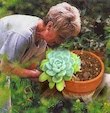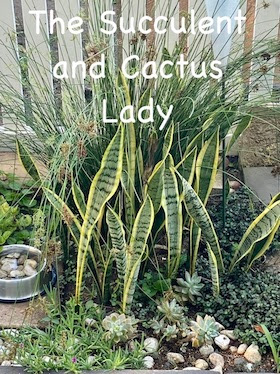Other recorded uses include: insect bites and bluebottle stings, fungi, toothache, sunburn, as protection against the elements and to stimulate the immune system, to name a few.
About me

🌿 I've been gardening ever since a child, when I spent time with my father in his vegetable garden. But my fascination with Echeverias started in the 1980's, when my father gave me a pot with five Echeverias, which turned out to be E. imbricata. At first I wasn't much interested in them and planted them in some obscure corner of the garden and completely forgot about them. How great was my surprise when, a couple of months later, I noticed that they had spread and made a beautiful display - I was hooked!
Pages
Friday 16 February 2024
Aloe vera splendour
Friday 16 June 2023
Fairy Crassula
My Crassula multicava (Fairy Crassula) is in full bloom. It is a neatly-growing evergreen low-growing plant that rarely exceeds a foot tall in the landscape and is even lower when grown in dry shade.
Indigenous to South Africa, this Crassula occurs naturally along forest margins, riparian areas and within coastal vegetation from Mpumulanga (Eastern Transvaal), Natal to the Eastern and southern Cape provinces.
The beautiful petite flowers, which are pink in bud and then open to charming little white stars that are very showy as a spray above the foliage on reddish stems, appear in Winter.
Read more HERE.
Monday 1 May 2023
Eve's Needle (Looking back)
(Austrocylindropuntia subulata)
.
Family: Cactaceae (kak-TAY-see-ee)
Genus: Austrocylindropuntia (oss-troh-sil-in-droh-PUN-tee-uh)
Species: subulata (sub-yoo-LAH-tuh)
.
In February 2014, my dear friend Elizabeth Kendall sent me a tiny piece of this Eve’s Needle through the post. Unknown to us, the Post Office was on strike and after a month of being missing in action, the parcel finally arrived with the poor little Eve’s Needle definitely looking worse for the wear. I immediately prepared a pot with some good soil, ample drainage and carefully transplanted her to her new home. Now, almost 8 months later, she has transformed into a beautiful specimen, standing almost 40cm (15") tall.
.
Austrocylindropuntia subulata is a large tree-like cactus, up to 13 feet (4 m) tall with round cylindrical joints, up to 2 feet (60 cm) tall and 1.5 – 2.5 inches (4 – 6.5 cm) thick. The green leaves are nearly cylindrical, up to 5 inches (13 cm) long. The spines are light yellow, 1 – 2 per areole, up to 3 inches (8 cm) long. The flowers are red, 2 – 4 inches (5 – 10 cm) long, followed by reddish to red fruits up to 4 inches (10 cm) long.
.
This plant is suitable for growing indoors or in containers, is drought-tolerant and produces beautiful red blooms. Needs regular watering but be careful not to over-water.
Native to the higher elevations of Ecuador and Peru, this plant was originally introduced to South Africa for the biological control of Opuntia ficus-indica, Eve’s Needle has been declared a Category 1 weed in South Africa as it is a great invader. When the plant gets top-heavy, pieces break off and take root where they fall, soon forming a dense wall of cactus killing anything that grows in its path. So I will be very careful to contain Eve in her pot, trimming regularly and keeping an eye out for any fallen leaves, needles or little pieces that might break off.
UPDATE : My Eve's Needle in March 2016, ready to be planted into a suitable spot in the garden where it will be easily controlled so that it doesn't spread as it is regarded as a bit of a pest here in South Africa. I also found this information that The Eve's needle will rarely bloom in cultivation, but when it does, it produces long, coppery red, showy blooms. Its fruit is oblong with small spines.
.
Wednesday 26 April 2023
Close friends
Friday 21 April 2023
Sweeping your mind
Sunday 11 December 2022
Spekboom splendour
Tonight all my Spekbooms (Portulacaria afra) look spectacular after a few days of rain - they actually do much better with more water than less, but they are absolute die-hards and will just go into rest-mode during a severe drought.
And just in case you wondered, these pics were really taken tonight. The iPhone 11 Pro actually has quite a spectacular camera.
Sunday 8 May 2022
Waiting for the rain
I never thought I’d be saying, ‘waiting for the rain’ so soon after the massive floods we had here on the Dolphin Coast a mere three or four weeks ago (we had 244mm in less than 23 hours), but if I don’t bring out the hosepipe soon, I’m going to have a very grumpy succulent garden on my hands. Under the Tradescantia (above), the Callisia repens is dry and brittle and I have actually removed huge patches of it (they spread like a wild-fire anyway) to make way for new growth. Provided I water it. All the plants here at the coast are used to regular rain, at least twice a week, so no rain for the past month is not good.
Monday 2 May 2022
Spekboom, loved by elephants and butterflies alike
Spekboom also make great container plants and already the birds enjoy roosting in the one above as it is near their favourite bathing place. Spekboom is totally edible and widely used in salads. I've often seen the birds taking bits of the leaves. The taste of spekboom leaves are pleasant but changes throughout as the sun rises and sets. During the day leaves have an acid flavour and they become less acidic towards the evening. The delicious greenery is heavily browsed by game and firm favourite of several wild animals, especially elephants! There the English name of Elephant Bush.
The leaves are used medicinally and in traditional home construction. Here are the most popular traditional and contemporary uses of spekboom leaves:
- - Sucking a leaf to quench thirst, treat exhaustion, dehydration and heatstroke.
- - Using crushed leaves to provide relief for blisters.
- - Chewing leaves can treat a sore throat and mouth infections.
- - Juiced leaves are used as an antiseptic and to soothe skin ailments such as pimples, rashes, - insect stings and sunburn.
- - In certain areas, the stems are used to help build huts/homes. The stems are dried and used as thatch for rooves of the huts/homes.
- - In Mozambique, breastfeeding mothers eat spekboom leaves to increase their milk supply.
- - During famine, the Zulus eat the leaves raw.
- (This information from Shamwari Game Reserve)
The spekboom flowers are nectar-rich and provide food for many insects – endangered bees love them! This, in turn, attract insectivorous birds.
Tuesday 29 March 2022
Sansevieria, a feng shui favourite
Mother-in-Law’s Tongue or Sansevieria trifasciata is native to Asia and Africa. Snake plants (Sansevieria) have a number of health benefits. They filter indoor air, remove toxic pollutants, may help boost mental health, are easy to care for, are effective against allergies and may help enhance the “energy” of a space, according to feng shui, therefore they are ideal in the bedroom.
In the garden they thrive in full sun as well as partial shade and quickly spread through rizomes. They are also great in pots indoors or on the patio.
::
Sunday 27 March 2022
Easy-going Graptoveria
If you’re looking for a succulent that’s easy to care for and propagates readily, get hold of a Graptoveria fantome. By propagating leaves, you will never have to buy another one and will soon have enough plants to start a nursery!
Saturday 31 July 2021
My new little patch of Sansevieria
Thursday 22 July 2021
Just be patient...
These are a few of the succulents I've been propagating over the last months - you just cannot keep a succulent-lover down! Right?
Wednesday 21 July 2021
Winter splendour at the Coast
This is the time of year (Winter) when these striking flowers are at their best. Aloes attract a variety of insects and birds, particularly Sunbirds.
Take a moment to watch them.
Other recorded uses include: insect bites and bluebottle stings, fungi, toothache, sunburn, as protection against the elements and to stimulate the immune system, to name a few.






4045a.jpg)

















































